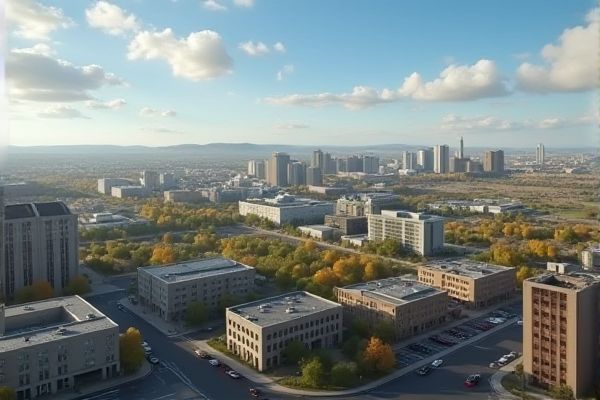
Moving to South Dakota checklist: Research cost of living. Understand weather patterns. Explore job opportunities. Find housing options. Check healthcare facilities. Familiarize with local laws. Look into education systems. Discover outdoor activities. Identify local amenities. Plan for wildlife encounters.
Research cost of living.
The cost of living in South Dakota is notably 7% lower than the national average. This economic advantage is further enhanced by housing costs, which are 12% lower, and utilities, which are 13% lower. South Dakotans also benefit from reductions in other essential areas such as food, healthcare, transportation, and goods & services. For more detailed insights, the Cost of Living Calculator provides a comprehensive breakdown of these expenses, helping to paint a clearer picture of the financial benefits of residing in this state.
Understand weather patterns.
South Dakota experiences four distinct seasons: spring with mild temperatures and occasional rain, summer with hot and semi-humid conditions, fall with mild days and cool nights, and winter with cold and snowy conditions, varying between the eastern and western parts of the state due to differences in humidity and precipitation. When planning a trip, it is essential to pack accordingly based on the season, with warm clothing for winter, light and breathable attire for summer, and layers for both spring and fall. For more detailed information on the climate and how to prepare, visit the comprehensive Travel South Dakota Website.
Explore job opportunities.
Explore job opportunities in South Dakota using SDWORKS, the state's online jobs database, and utilize various resources such as staff-assisted help, job search workshops, and training opportunities provided by the Department of Labor and Regulation. Additionally, Dakota Roots offers free services to connect out-of-state job seekers with career opportunities and communities in South Dakota, matching your skills and experience with suitable lifestyle options.
Find housing options.
For those seeking affordable housing, the Governor's House Program offers an excellent opportunity with its low-maintenance, energy-efficient homes designed for income-qualified individuals, particularly seniors, those with disabilities, and low- to moderate-income households. If you are considering rental options, SD Housing provides valuable rental assistance programs, including Project Based Section 8 and Tenant-Based Section 8 (Housing Choice Voucher), aimed at offering affordable rental housing for low-income families, seniors, and individuals with disabilities. Additionally, to explore a wide range of homes for sale, Zillow's South Dakota real estate listings provide comprehensive options, including detailed photos, sales history, and specialized real estate filters to help find the perfect home.
Check healthcare facilities.
South Dakota has 58 hospitals, including 40 Critical Access Hospitals that support rural communities, with various facilities providing inpatient, outpatient, and emergency care services. You can check the list of hospitals through the South Dakota Association of Healthcare Organizations, their bed capacities, and the services they offer to ensure access to healthcare in the area you plan to move to.
Familiarize with local laws.
To familiarize yourself with local laws in South Dakota, review the state's driver licensing manual, which outlines requirements and regulations for obtaining a driver's license or ID card, including document requirements and specific laws related to driving. Additionally, you can visit the official State Government Website for information on various state agencies and their roles in enforcing local laws.
Look into education systems.
In South Dakota, the education system includes compulsory public education from kindergarten to 12th grade, with curriculum standards set by the state and implemented by school districts. The system also offers special programs like the "South Dakota Sturdy" curriculum for life skills, Advanced Placement (AP) and International Baccalaureate (IB) courses, and specialized schools for the deaf and visually impaired.
Discover outdoor activities.
South Dakota offers a wide range of outdoor activities, including hiking through the Badlands, ATV riding in the Black Hills, boating on lakes and rivers, biking, birding, camping, fishing, golfing, horseback riding, hunting, motorcycling, rock climbing, winter activities, water sports, and wildlife viewing. Whether you're seeking thrilling adventures or serene landscapes, South Dakota's diverse landscapes provide ample opportunities to explore. For more information on activities and destinations, visit their Outdoor Activities page. Experience the breathtaking beauty and excitement that this remarkable state has to offer for outdoor enthusiasts of all kinds.
Identify local amenities.
South Dakota is a state rich with local amenities and diverse attractions for both residents and visitors. From the captivating outdoor activities available in the Black Hills and Badlands to the renowned cultural landmarks such as Mount Rushmore and the Crazy Horse Memorial, there is something for everyone. For those seeking a vibrant city experience, places like Brookings and Aberdeen offer dynamic city life complete with parks, gardens, and a variety of cultural centers. Each city presents its unique attractions, such as the Children's Museum of South Dakota in Brookings and The Redlin Art Center in Watertown. Additionally, cities like Watertown offer recreational activities along the Missouri River, providing museums, art galleries, historic homes, and beautiful outdoor spaces. To get a deeper insight into what these cities have to offer, including more about the lively City Life of South Dakota, you can explore cultural sites, nature, and modern amenities that make this state a distinctive place to visit or reside.
Plan for wildlife encounters.
When moving to South Dakota, it is essential to plan for wildlife encounters by maintaining a safe distance from animals, especially bison, with a recommended distance of at least 100 feet. It's crucial to avoid feeding or approaching wildlife and to be aware of your surroundings to prevent surprise encounters with animals such as bison, prairie rattlesnakes, and other wildlife. Additionally, strategies like making noise while hiking and avoiding hiking at dawn or dusk are important. Following the Leave No Trace principles is also vital to respect and safely coexist with the wildlife.
